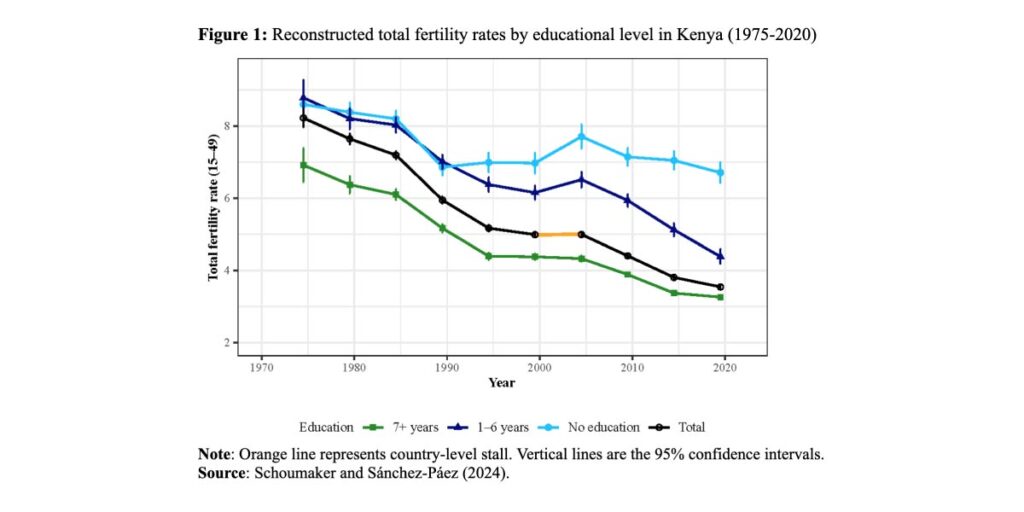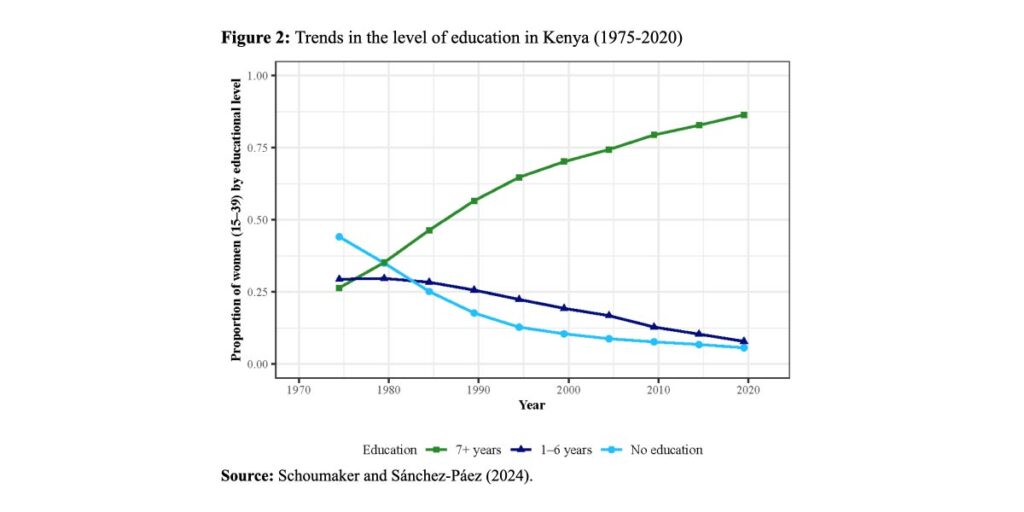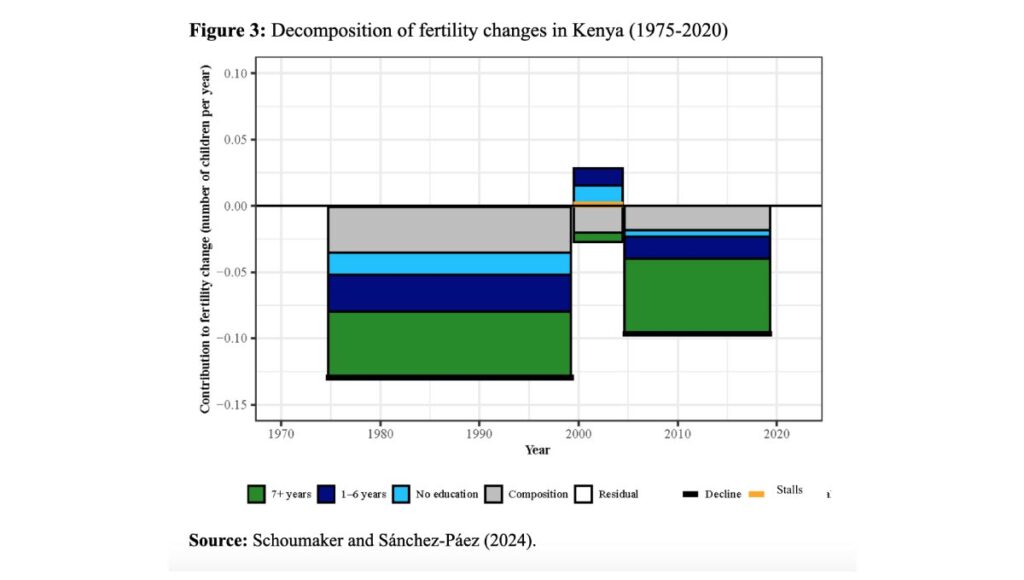Progress in education has been uneven in sub-Saharan Africa, which may have contributed to slowing or halting fertility decline. Bruno Schoumaker and David A. Sánchez-Páez note that fertility has stalled even in the context of educational progress which depends largely on fertility stagnation within educational groups.
The fertility transition in sub-Saharan Africa (SSA) has been different than in other low- and middle-income countries: it began later, started from higher fertility levels, and has occurred at a slower pace (Bongaarts 2017). Moreover, fertility stalls, i.e. periods of very slow or no decline in fertility rates above replacement levels, have been identified in several countries since the early 2000s, contributing to the overall slow decline in fertility in SSA (Schoumaker 2019).
Educational progress and fertility changes
Women’s education affects fertility through three main channels: better-educated women typically desire fewer children, utilize contraceptives more frequently, and often delay childbearing by postponing marriage and the onset of sexual activity (Bongaarts et al. 2017; Liu and Raftery 2020; Shapiro and Tenikue 2017). In SSA, women with at least some secondary education tend to have between two and three fewer children than those without formal education (Tabutin and Schoumaker 2020). Given the prominent role of education in shaping demographic behavior, its impact on fertility stagnation in SSA is expected to be important. However, previous studies have led to mixed evidence. Some of them showed that the slow progress of education partly accounts for recent fertility stalls in some SSA countries (Goujon, Lutz, and KC 2015; Kebede, Goujon, and Lutz 2019). However, cases of fertility stalls have been found also in countries with robust progress in education (Sánchez-Páez and Schoumaker 2022). In addition, previous studies have often relied on aggregate data and have not distinguished the effect of changes in the population’s education level (the composition effect) from the fertility changes within educational groups (the rate effect).
Unraveling the links between education and fertility in the context of stalls
In a recent study (Schoumaker and Sánchez-Páez 2024), we used Demographic and Health Surveys and Multiple Indicator Cluster Surveys to identify the effects of changes in the educational composition of the population and fertility changes within educational groups on fertility stalls in 33 SSA countries since the 1970s. We first reconstructed fertility trends by educational level in each country, and assessed the relative role of the composition and the rate effect in explaining fertility stalls.
Out of the 33 countries, we identified 14 fertility stalls at the national level. Figure 1, for instance, illustrates fertility trends by educational level in Kenya between the 1970s and late 2010s. We find that the fertility stall in the early 2000s (orange line) coincides with periods of stalled fertility in all (three) educational groups. This pattern is observed in most of the 14 countries, indicating that fertility stalls are a collective experience across educational groups.

During the same period, levels of education continued to increase in Kenya (Figure 2). The share of better-educated women in the total population went from 25% in the 1970s to more than 80% around 2020. While the improvement in educational levels slightly leveled off in the early 2000s, this slowdown cannot account for the country-level stall.

Figure 3 further confirms the major role of fertility stalls within educational groups (rate effects) in the country-level stall, while educational progress (composition effects – grey area in Figure 3) has consistently pushed in the “right” direction, although with somewhat decreasing strength. The y-axis represents the average annual fertility change during the period: during periods of fertility decline (negative values), all educational groups contributed (rate effects, in blue and green), and so did the increase in education (composition effect, in grey). Instead, during the stall period of the early 2000s, fertility increases among women with no or low education were the major driver of the stall. Similar results were found in most of the 14 countries where stalls in fertility decline were noted in the past 40 years or so.

Conclusions
In none of the 14 countries characterized by fertility stalls has the change in educational composition been the driving factor: stalls were instead caused by stagnating or even increasing fertility within educational groups. As these trends occurred more or less simultaneously within all educational groups, some common cause has probably determined them, such as stagnating fertility preferences, or lack of access to contraception.
In countries where a large proportion of the population has no education, future fertility trends will depend mostly on the fertility of less-educated women, given their large weight in the population. In countries where education is already widespread, stalls are likely to persist and fuel further population growth, unless fertility declines further among more educated women.
References
Bongaarts, J. (2006). The causes of stalling fertility transitions. Studies in Family Planning 37(1): 1–16. doi: 10.1111/j.1728-4465.2006.00079.x.
Bongaarts, J. (2017). Africa’s unique fertility transition. Population and Development Review 43(S1): 39–58. doi:10.1111/j.1728-4457.2016.00164.x.
Bongaarts, J., Mensch, B.S. and Blanc, A.K. (2017). Trends in the age at reproductive transitions in the developing world: The role of Education. Population Studies 71(2): 139–154. doi: 10.1080/00324728.2017.1291986.
Goujon, A., Lutz, W. and KC, S. (2015). Education stalls and subsequent stalls in African fertility: A descriptive overview. Demographic Research 33(47): 1281–1296. doi: 10.4054/DemRes.2015.33.47
Kebede, E., Goujon, A. and Lutz, W. (2019). Stalls in Africa’s fertility decline partly result from disruptions in female education. Proceedings of the National Academy of Sciences 116(8): 2891–2896. doi: 10.1073/pnas.1717288116
Liu, D.H. and Raftery, A.E. (2020). How do education and family planning accelerate fertility decline? Population and Development Review 46(3): 409–441. doi: 10.1111/padr.12347
Sánchez-Páez, D.A. and Schoumaker, B. (2022). Fertility Transition in Africa: What do we know and what have we learned about Fertility Stalls? In C. Odimewgu and Y. Adewoyin (Eds.), The Routledge Handbook of African Demography (pp. 216–251). London: Routledge. doi: 10.4324/9780429287213-15.
Schoumaker, B. (2019). Stalls in fertility transitions in sub-Saharan Africa: Revisiting the evidence. Studies in Family Planning 50(3): 257–278. doi: 10.1111/sifp.12098.
Schoumaker, B. and Sánchez-Páez, D.A. (2024). Disruptions in educational progress and fertility dynamics by educational level: Unraveling the link between education and fertility stalls in sub-Saharan Africa. Population and Development Review 50(1): 59–85. doi: 10.1111/padr.12610.
Shapiro, D. and Tenikue, M. (2017). Women’s education, infant and child mortality, and fertility decline in rural and urban sub-Saharan Africa. Demographic Research 37(21): 669–708. doi: 10.4054/DemRes.2017.37.21
Tabutin, D. and Schoumaker, B. (2020). The demography of sub-Saharan Africa in the 21st century. Population 75(2): 165–286. doi: 10.3917/popu.2002.0169.


